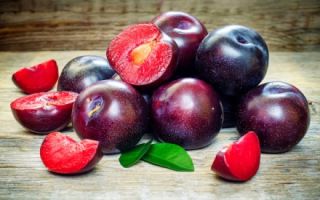Content
- 1 Composition and calorie content of plums
- 2 The benefits of plums for the human body
- 3 For men's health
- 4 Is it possible for children to have plums and at what age
- 5 The benefits of plum for weight loss
- 6 The use of plums in traditional medicine
- 7 Rules for the use of plums for various diseases
- 8 Plum masks for face and hair
- 9 How can you eat plums
- 10 The benefits and harms of plum juice
- 11 Plum bones: use and application
- 12 The benefits of plum leaves and twigs
- 13 The benefits of yellow plum
- 14 How to store and choose plums correctly
- 15 The harm of plums and contraindications
- 16 Conclusion
The benefits and harms of the plum have been known to mankind since the appearance of this fruit. Several thousand years ago, in the area of modern Turkey, a plant was obtained that was a hybrid of blackthorn and cherry plum. The plant was successful: it combined the taste of cherry plum with the cold resistance of blackthorn. But this did not end there. Most of the beneficial properties of the blackthorn have also been transferred to this hybrid. As a result, the plum is a repository of two sets of nutrients at once - characteristic of cold and warm latitudes.
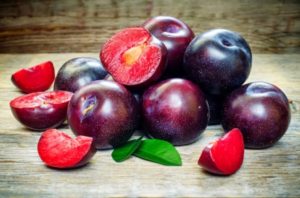
Composition and calorie content of plums
The composition of 100 g of fruit contains the following vitamins:
- vitamin A - 17 mcg;
- vitamin B1 - 60 mcg;
- vitamin B2 - 40 mcg;
- vitamin B5 - 150 mcg;
- vitamin B6 - 80 mcg;
- vitamin B9 - 1.5 mcg;
- vitamin C - up to 10 mg;
- vitamin PP - 0.7 mg;
- vitamin E - 600 mcg.
In addition, plums contain about 100 mcg of provitamin-A and about 600 mcg of niacin.
The trace element composition of the product is as follows:
- potassium - 210 mg;
- calcium - 20 mg;
- silicon - 4 mg;
- magnesium - 10 mg;
- sodium - 18 mg;
- phosphorus - 20 mg.
The plum contains 9.5% sugars, which account for:
- sucrose - 4.8%;
- glucose - 3%;
- fructose - 1.7%.
The nutritional value of plums is as follows:
- proteins - 7.2%;
- fats - 6.1%;
- carbohydrates - 86.7%.
The calorie content of plums per 100 grams is 49 kcal;
The calorie content of 1 plum is about 15 kcal.
The benefits of plums for the human body
The main benefit of fresh plum is its effect on the digestive tract. With the help of this fruit, a gentle cleansing of the stomach and the normalization of intestinal activity are performed.
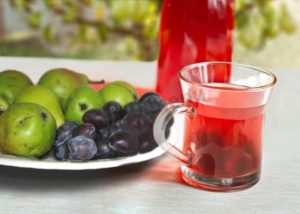
The question of whether the drain strengthens or weakens has long been tested in practice and has an unambiguous answer. Due to the acids contained in the fruit, irritating the walls of the stomach, it has a mild laxative effect.
The weak diuretic effect of the fruit helps cleanse the kidneys and the excretory system as a whole.
In addition, the fruit is rich in vitamins and minerals that are important for the body. Especially noteworthy is its positive effect on the circulatory and cardiovascular systems. The substances of the P-vitamin composition contained in it normalize blood pressure. The coumarins found in fruits help prevent thrombosis.
The fruit is considered useful in atherosclerosis, as it cleans the walls of blood vessels and partially removes cholesterol deposits.
The benefits of black plum are in a higher concentration of vitamin B2, which normalizes protein metabolism and restores the nervous system.
For a woman's body
For the female body, the fruit will be useful in the case of the following health disorders:
- with constipation;
- metabolic disorders;
- anemia.
The latter is especially important, since due to menstruation in the body of women, a decrease in the level of hemoglobin in the blood is often observed. The iron contained in plums is capable of providing an effective adjuvant therapy for this disease.
In addition, plums are used by women for weight loss and in cosmetology. The use of fruits in various cosmetic recipes stimulates collagen synthesis and leads to skin rejuvenation.
Is plum good for pregnancy and breastfeeding
The use of plums during pregnancy and lactation has not yet been clarified. On the one hand, the presence of useful substances (vitamin complex and iron with calcium) is very good for the body of the mother and child, on the other hand, the high activity of the plum components can cause both discomfort and even cause serious disorders.
Therefore, it is currently recommended to consume plums, only starting from the second month of breastfeeding, and do this gradually, observing the reaction of the baby and the mother's body.
For men's health
Plum is useful for men primarily due to the acceleration of metabolism in the body and a general increase in tone. Fruits contain a lot of calcium, which will have a beneficial effect on the male skeletal system, to a greater extent than the female, subject to physical exertion.
Consuming plums is believed to further stimulate testosterone production and improve prostate function.
For seniors
Beneficial for the elderly in the drain will be primarily its cleansing actions related to both the gastrointestinal tract and the cardiovascular system (treatment and prevention of atherosclerosis).
Equally important is the high calcium content, which is so necessary for the skeletal system of the elderly, since bones become fragile with age.
Is it possible for children to have plums and at what age
In its pure form, the benefits of plums for babies at too early age are questionable. Even the most radical nutritionists recommend introducing the first plum complementary food after 6 months, and then on condition that other vegetable complementary foods have already been introduced before.

Classical schools of nutritionists generally do not recommend the introduction of plum complementary foods before 9 months. In this case, the plum should not be given in its pure form, but in the form of a compote from dried fruits (prunes). Switching to puree plums is recommended around the age of 1 year. Such caution is due to the high allergenicity of plums for the child and the immaturity of his digestive tract.
In exceptional cases, to combat constipation at an early age, it is allowed to use a decoction of prunes even from 4 months, but in very small doses and after consulting a pediatrician or doctor, as well as under their constant supervision.
The benefits of plum for weight loss
Plum can be used for weight loss due to its cleansing properties. In addition, there are several diets based on this fruit. In particular, the well-known plum diet, the essence of which consists in two fasting plum days, the repetition of which is allowed no earlier than once every two weeks.
Such a diet allows you to lose about 1.5 kg of excess fat within a few days. The diet is considered strict, that is, during fasting days, only one product is used. In this case, it is allowed to consume non-nutritive liquids. Most often, tea or mineral water acts as such.

For a diet during each of the two fasting days, you must consume the following foods:
- fresh plums - 1 kg;
- water (you can use slightly acidic mineral water without gas) - 1.5 liters;
- tea (green or herbal; black is highly undesirable to use) - up to 1 liter.
Fruit for this diet should be selected according to the following criteria:
- be sure to be ripe;
- if possible, choose varieties with a low sugar content;
- shouldn't be too sour.
The fruits are washed, dried and divided into 5 parts, after which they are eaten during the day at regular intervals. They are similarly divided into 5 parts and liquids. Tea is preferably drunk 30 minutes before draining, water - 30 minutes after.
Instead of plums for one or two meals, you can use plum juice.
In the following days (at least 5-7), you must adhere to the following rules of food intake: give up sweet and flour dishes, alcoholic beverages and fast food. It is advisable to reduce the use of fried foods as much as possible.
In addition, the last meal (dinner, but preferably afternoon tea) should be replaced with a portion of fresh plums, washed down with tea and water, as on a fasting day.
The use of plums in traditional medicine
The use of the fruit in traditional medicine repeats its use in traditional medicine.
In its raw form, fruits are used to improve the functioning of the intestines, to cleanse the body and improve well-being.
Decoctions from leaves and twigs are used to heal wounds, prevent upper respiratory tract diseases, and cleanse the kidneys.
Juices and compotes are usually used in cases where there is no need to cleanse the intestines with fiber, etc.

Rules for the use of plums for various diseases
The use of plums for certain diseases should be done with caution, given the active nature of some components of the fruit.
With gastritis
It is allowed to consume no more than 3-5 ripe fruits per day. You can use the juice, but dilute it with water in a ratio of 1 to 2.
With pancreatitis
It is allowed to eat 3-4 ripe fruits without peel per day. Use is possible only after eating. During periods of exacerbation, it is allowed to eat 1-2 plums without a peel, but if the diagnosis of pancreatitis was made more than 3 years ago. In the early years of the disease, plums with exacerbation are prohibited.
With gout
The use of fruits is limited to 3-4 pieces. per day. Can be taken after meals.
With diabetes mellitus
Restriction on the mass of fruits eaten: no more than 150 g of raw plums per day; prunes - no more than 40 g per day. The main criterion for limiting is the calorie content of the product.
Plum masks for face and hair
The chemical composition of the fruit makes it an indispensable remedy for skin rejuvenation and hair strengthening.

The easiest way to use masks is to apply the crushed fruit pulp to the face, where it is kept for about 20 minutes.
A face mask with a cleansing effect is made as follows: the pulp of 2-3 fruits is peeled and kneaded to a state of gruel. Add 1 tbsp to it. l. onion juice and 1 minced clove of garlic. The mask is applied to the steamed skin, where it is kept for 15 minutes, after which it is washed off with warm water.
The hair mask is done like this: juice is squeezed out of 6 plums and 1 tsp is added to it. starch and honey, as well as 0.5 tsp. yoghurt. Everything is thoroughly mixed and applied to the hair for 30 minutes. After the procedure, the mask is washed off with shampoo.
How can you eat plums
Plums can be used in a wide variety of forms. It can be raw fruits, desserts, jams, preserves made from them. There are many plum-filled flour dishes. The benefits of plum jam are in no way inferior to those of raw plums, and it is very pleasant to eat something vitamin-rich in winter, and besides, tasty.
There are also many exotic dishes, mostly pastry shops. These include plums in syrup, plums with nuts and sugar, plum lozenges, and much more. But there are also not quite ordinary combinations among them: for example, pickled plums and plums with lemon, used as a side dish for meat dishes.
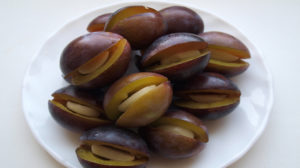
Plum compote and plum juice are very popular.
The fruit has the unique property of retaining almost all useful qualities during heat treatment. There are about a dozen ways to preserve plums.
The benefits and harms of plum juice
The juice repeats all the positive (as well as negative) properties of the plum. However, when using it, it should be remembered that due to the removal of the solid fraction, the concentration of most of the components that make up the fruit increases significantly.
This imposes restrictions on the amount of juice that can be used without consequences during the day. It is believed that the daily dose of plum juice should not exceed 300 ml, while it is recommended to consume no more than 100 ml at a time. The calorie content of plum juice is 39 kcal, which is almost 20% less than that of raw fruits.

The benefits of plum compote are also almost identical to those of raw plums. However, due to heat treatment and the addition of sugar, its calorie content will be twice as high as that of raw fruits (almost 100 kcal). This should be taken into account by people with obesity and metabolic disorders.
Plum bones: use and application
The oil contained in the seeds is a good remedy for ascariasis, however, it is not recommended to use them without special cleaning, which cannot be done at home.
In order for the oil to have its therapeutic effect, it should be consumed quite a lot, up to several grams. In this case, the amount of cyanide introduced into the body will pose a health hazard. That is why it is forbidden to use seeds or oil squeezed out of them yourself.
For therapeutic purposes, only industrially produced plum seed oil is allowed to be consumed. This will avoid lethal components.
The benefits of plum leaves and twigs
Plum leaves and twigs are used to prepare decoctions and infusions to help treat injuries of various types, both internal and external. These decoctions are used in cases:
- periodontal disease;
- long healing wounds;
- wounds with purulent discharge;
- inflammation of the kidneys and bladder;
- microtraumas of the upper respiratory tract with coughs and colds.
The broth is prepared as follows: in one liter of boiling water for 20-30 minutes. 150-200 g of leaves or young plum branches are brewed. Then it is filtered, cooled and used for washing wounds or ingestion.
The benefits of yellow plum
The benefits of this fruit lie primarily in the increased concentration of potassium and pectins. Potassium has a beneficial effect on the heart and the circulatory system in general. It also enhances the diuretic effect of fruits compared to ordinary garden plums.
The increased concentration of pectins promotes the elimination of more toxins and waste products from the body.
How to store and choose plums correctly
When choosing a plum, first of all, pay attention to the appearance of the fruit, in particular to its uniform color. Fully ripe fruits are darker and softer, but should regain their shape after light pressure. Ripe fruits have a distinctive flavor and aroma.
Plums do not always ripen when plucked, so you should not take even slightly unripe fruits.
When choosing, fruit with cracks, dents and spots should be discarded.
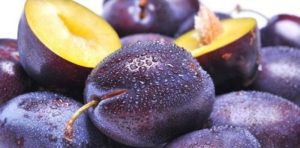
Plums can be stored in the refrigerator for no more than 5 days. If the product needs to be frozen, it should be washed and pitted. Freezing in the freezer is best done by storing the fruit in plastic containers.
The benefits of frozen plums are the same as those of fresh ones, because when frozen, even at home, thanks to the cell structure of the fruit, the fruit retains all its properties.
The harm of plums and contraindications
Despite its many beneficial properties, plums can cause discomfort and even seriously aggravate your health, if you do not adhere to contraindications.
These include:
- overeating fruits with diabetes mellitus (plums can contain up to 10% sugars, therefore, it is contraindicated to consume fruits in large quantities for such patients);
- urolithiasis disease;
- advanced gout;
- gastritis in the acute stage;
- rheumatism;
- renal failure;
- problems of the urinary tract (obstruction, prostatitis, etc.);
- individual intolerance and allergies.
The last of the listed contraindications are quite rare, but can manifest themselves in childhood.
Conclusion
The benefits and harms of plums are well researched and documented. This delicious fruit has many beneficial properties and has a cleansing and rejuvenating effect on the body. However, one should not forget about contraindications - fruits contain a large amount of chemically active substances, the effect of which on the body can be varied.

